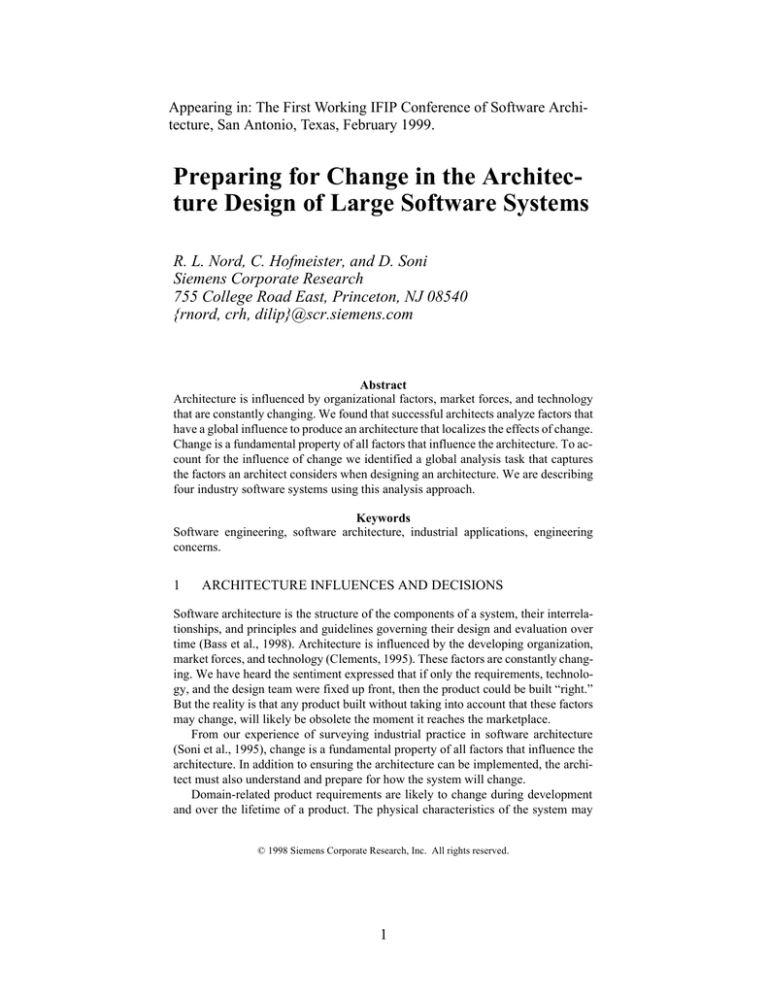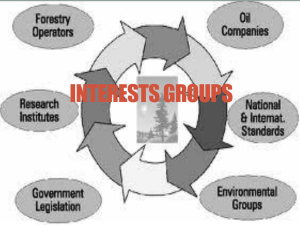
Appearing in: The First Working IFIP Conference of Software Architecture, San Antonio, Texas, February 1999.
Preparing for Change in the Architecture Design of Large Software Systems
R. L. Nord, C. Hofmeister, and D. Soni
Siemens Corporate Research
755 College Road East, Princeton, NJ 08540
{rnord, crh, dilip}@scr.siemens.com
Abstract
Architecture is influenced by organizational factors, market forces, and technology
that are constantly changing. We found that successful architects analyze factors that
have a global influence to produce an architecture that localizes the effects of change.
Change is a fundamental property of all factors that influence the architecture. To account for the influence of change we identified a global analysis task that captures
the factors an architect considers when designing an architecture. We are describing
four industry software systems using this analysis approach.
Keywords
Software engineering, software architecture, industrial applications, engineering
concerns.
1
ARCHITECTURE INFLUENCES AND DECISIONS
Software architecture is the structure of the components of a system, their interrelationships, and principles and guidelines governing their design and evaluation over
time (Bass et al., 1998). Architecture is influenced by the developing organization,
market forces, and technology (Clements, 1995). These factors are constantly changing. We have heard the sentiment expressed that if only the requirements, technology, and the design team were fixed up front, then the product could be built “right.”
But the reality is that any product built without taking into account that these factors
may change, will likely be obsolete the moment it reaches the marketplace.
From our experience of surveying industrial practice in software architecture
(Soni et al., 1995), change is a fundamental property of all factors that influence the
architecture. In addition to ensuring the architecture can be implemented, the architect must also understand and prepare for how the system will change.
Domain-related product requirements are likely to change during development
and over the lifetime of a product. The physical characteristics of the system may
© 1998 Siemens Corporate Research, Inc. All rights reserved.
1
change as new models are introduced. The way users interact with the system is likely to change as they become more sophisticated in using the system and desire more
effective ways of using it. As the processing power increases, work that was previously the responsibility of the users shifts to the system.
The technology and requirements affecting the run-time structure of the system
are likely to change over the lifetime of the product. It is desirable to port the product
to new hardware and that may mean adapting to a new software platform as well. The
architecture may change as the system is tuned to meet its performance requirements.
The performance characteristics aren’t always entirely predictable. Changes in the
assignment of components to tasks and task attributes may be needed as the system
is tuned.
Aspects of change are typically recorded as a requirement or quality goal. For example, the quality goal “ease of change” is documented and realized in the architecture by information hiding (Parnas, 1972). We soon found from our experience that
we needed additional information to capture the rationale for the architecture. We
needed a more precise meaning of change. Change could mean adding new features,
upgrading hardware, or increasing the data rate specified in a requirement. We needed to express a repertoire of design strategies. Information hiding is one important
strategy, but there are additional means to separating software engineering concerns
to prepare for future changes. We needed a way to trace the factors to aspects of the
architecture at a finer level of granularity.
To account for the influence of change we identified a global analysis task that
starts as the architecture is defined. Its purpose is to capture the global influencing
factors an architect considers and their relationship to strategies that will be used
throughout the architecture design. A common set of strategies guiding the developers ensures the integrity of the architecture. This is an iterative process. During the
design, certain decisions feed back into the global analysis, resulting in new strategies.
2
GLOBAL ANALYSIS
Global analysis begins with identifying the factors that affect the design of the architecture. These influencing factors fall into three categories: organizational, technological, and product. Table 1 lists typical categories of influencing factors based on
our observations. Within each category there will be a number of factors. For example, the schedule (O4) will record the time to market and how features are to be delivered.
2
Table 1: Example Categories of Influencing Factors
Organization
Technology
Product
O1: Management
T1: General-purpose
Hardware
P1: Features
O2: Staff Skills
T2: Domain-specific
Hardware
P2: User Interface
O3: Development
Environment
T3: Software
Technology
P3: Performance
O4: Schedule
T4: Architecture
Technology
P4: Recovery
O5: Budget
T5: Standards
P5: Diagnostics
Organizational factors constrain the design choices. They are external to the
product being designed and exert influence on the product mostly during development. Their influence is important because if they are ignored, the architecture may
not be buildable. The technological factors are also external to the product being designed. Unlike the organizational factors, however, they can affect the product
throughout its lifetime. Further, they can change over time, so the architecture should
be designed with this changeability in mind. The product factors, including product
requirements, are the primary influence on the architecture. The product factors are
also subject to change over time, so the architecture should be designed to support
such changes.
The purpose of global analysis is to uncover all of the influencing factors and
identify strategies for handling them. The strategies address the global concerns, but
provide guidance for implementing them locally. These factors and strategies should
be recorded as part of the architecture. To arrive at these strategies we have identified
four steps: (1) identify and describe the factors, (2) characterize the changeability of
the factors, (3) analyze the impact of the factors, (4) identify the objectives and develop global strategies.
Step 1: Identify and Describe the Factors
At this early stage in the architecture design, the primary factors to consider are those
that have a significant global impact, those that could change during development,
those that are difficult to satisfy, and those with which there is little experience. To
determine whether a factor has a significant global influence, the architect should
3
ask: can the factor’s influence be localized to one component in the design, or must
it be distributed across several components; during which stages of development will
the factor be important; does the factor require any new expertise or skills?
We illustrate the steps with an excerpt from a data processing system. A probe
takes sensor readings that are processed according to the type of acquisition selected
by the user. For our example system, we record factors in each of the three categories
for illustrative purposes in Table 2. In Step 1, the first two columns are filled in.
Table 2: Characterization of the Influencing Factors
Factor
Description
Changeability
Impact
O4.2 Schedule
Feature Delivery
Features are prioritized
Negotiable
Moderate impact on
meeting the schedule.
T2.1 Domainspecific
Hardware
Probe Hardware
This is the hardware to detect
and process signals.
Probe hardware
upgraded every
three years as
technology improves.
Large impact on
components involved in acquisition and sensor
processing.
P1.1 Features
Acquisition
Types
Acquire raw signal data and convert into sensor
readings.
New types of acquisitions may be
added every three
years.
Affects acquisition
performance, sensor
processing, and user
interface.
The schedule factor shows the features to be delivered are prioritized. For other
systems these kinds of factors may not affect the architecture, but in this system they
will have a significant impact. For the domain-specific hardware, we have the probe
hardware. For product factors, there are a variety of acquisition algorithms to acquire
raw signal data and process it into a human readable form.
Step 2: Characterize the Changeability of the Factors
To characterize the changeability of a factor, the architect should ask: how likely will
this factor change; will the factor be affected by changes in other factors; how often
will the factor change; in what way could it change? These changes could arise either
from the volatility of the factor or from the need to be flexible in its usage.
The results of this step are shown in the third column of Table 2. The company’s
priority is time-to-market. There is flexibility in delaying non-critical features to a
later release. The system interacts with the domain-specific hardware of the probe.
We want to build flexibility into the system to allow for new models of the probe to
be introduced and for different hardware configurations to be specified (e.g., for low-
4
end to high-end products). Advances in hardware, software, and the application domain will likely drive changes in requirements as technology enables the user to do
new things. Acquisition types are expected to be added or enhanced every three
years.
Step 3: Analyze the Impact of the Factors
In this step the impact of the factors are analyzed. The impact of factors should be
recorded in terms of their impact on particular components; this is not possible if the
components have not yet been defined at this point in the architecture design. However, experienced architects will, even at this early stage, have a notion of the highlevel components of the system. As the design progresses, the impact of change can
be more precisely determined. To determine the impact of change for each factor, the
architect should ask, if the identified changes were to happen, would any of the other
factors, components, modes of operation of the system, or other design decisions be
affected, and if so how?
For the example system the schedule and flexibility of delivery of features have
a large and pervasive impact on almost all of the architecture design as noted in the
fourth column of Table 2. A change in the probe hardware affects all components involved in acquisition or sensor processing. Adding new features may affect the system’s performance, while any changes in the user interaction model will affect the
system interface.
Step 4: Identify Objectives and Develop Global Strategies
In this step, the important objectives are identified. These are critical issues that arise
from the need to reduce the impact of changeability of factors. For example, one
would like to design the architecture to reduce the cost of porting the system to another operating system. Strategies are developed to address identified objectives in
order to ensure the implementability and changeability of the design. Table 3 lists
some of the strategies we found in the example system.
Table 3: Examples of Strategies
Organization
Technology
Product
Reuse existing components
Encapsulate hardware
Use feature-based components
Build rather than buy
Separate processing,
control, and data.
Separate the user interaction model
Make it easy to add or
remove features
Use vendor-independent
interfaces.
Separate time-critical
components
5
Several factors may influence the same objectives, so strategies should be developed that balance these factors and benefit from their synergy. Each strategy needs
to be consistent with the characteristics of the influencing factors, their desired/required changeability, and their interactions with other factors. Strategies should address one or more of the following goals in order to ensure the buildability and
changeability of the architecture design: reduce or localize the factor’s influence, reduce the impact of the factor’s changeability on the design and other factors, reduce
or localize required areas of expertise or skills, reduce overall time and effort.
After reviewing the analysis for the example system, we identified objectives
such as: meeting an aggressive schedule, upgrading domain-specific hardware, easy
addition or removal of features, and high performance. Table 4 gives an overview of
some strategies to address the “Easy Addition or Removal of Features” objective.
Table 4: Objective - Easy Addition or Removal of Features
Influencing Factors
Applicable Strategies
Time to market is short.
Use a flexible pipeline model.
Delivery of features is negotiable.
Separate components along dimensions of concern.
New features can be added every three
years.
Encapsulate features into separate
components.
User interaction model must be adapted to new standards.
Designing the architecture to make it easy to add or remove features was motivated to help meet the aggressive schedule by trading off non-essential functionality
with time. However, designing a system for easy addition or removal of features is a
non-trivial problem. The solution uses the principle of separation of concerns to address the problem. We developed a flexible pipeline model for building acquisition
and processing applications. Acquisition and processing components can be used as
stages in the pipeline. This will allow us to quickly introduce new acquisition types
by constructing pipelines using old and new components. We followed the strategy
of separating components along dimensions of concern to build in flexibility to accommodate change in the architecture. We separated or decomposed modules along
important dimensions of concerns, including processing, communication, control,
data, and user interface aspects of the software design. This gives us the possibility
of using the modules in other applications or in contexts we cannot foresee at this
time. Application of this strategy will also allow us to allocate and trace the requirements to the design elements. When the requirements change, it will be easier to re-
6
use the existing framework and plug in new components to get a new solution more
quickly. To isolate the effects of change to product features, we encapsulated related
product features into separate components (e.g., movement of the probe, sensor processing, connectivity to the network).
3
CONCLUSIONS
To take into account the factors that influence the architecture, the architect considers and balances a number of strategies to come up with the appropriate architectural
decisions. In addition to implementation strategies that ensure that developers can
use the architecture to guide their implementation of the system, there are changeability strategies that ensure that the architecture will be able to provide a stable base
that can accommodate or localize the effects of changes in the organization, technology, and product factors.
We have found from our experience that successful architects prepare for likely
changes. They do this by noting the flexibility of the influencing factors and how
likely they are to change. They note how factors interact and what impact they have
in order to prioritize and evaluate what strategies are most cost effective in preparing
for change. We have observed this kind of analysis informally in a number of systems. We are in the process of describing four industrial software systems using this
global analysis approach (Hofmeister et al.).
4
REFERENCES
Bass, L., Clements, P., and Kazman, R. (1998) Software Architecture in Practice.
Addison-Wesley, Reading, Massachusetts.
Clements, P.C. (1995) Understanding Architectural Influences and Decisions in
Large System Projects, in Proceedings of the First International Workshop on
Architectures for Software Systems, Seattle, WA.
Hofmeister, C., Nord, R., Soni, D. (to appear) Applied Software Architecture. Addison-Wesley, Reading, Massachusetts.
Parnas, D. (1972) On the Criteria for Decomposing Systems into Modules. Communications of the ACM 15, 12, 1053-1058.
Soni, D., Nord, R.L., and Hofmeister, C. (1995) Software Architecture in Industrial
Applications, in Proceedings of the 17th International Conference on Software
Engineering, Seattle, WA.
7










